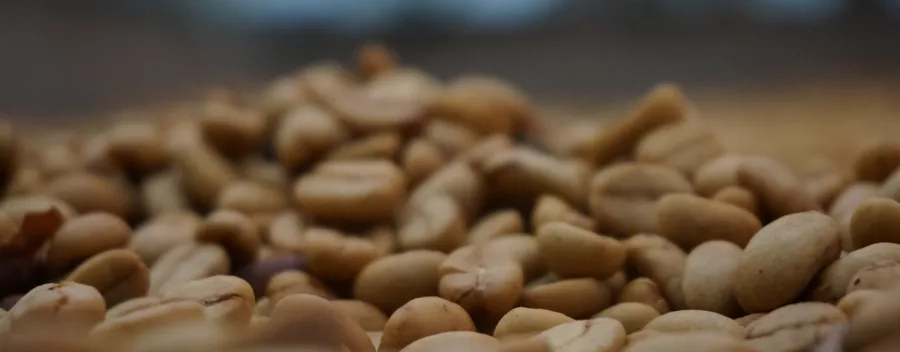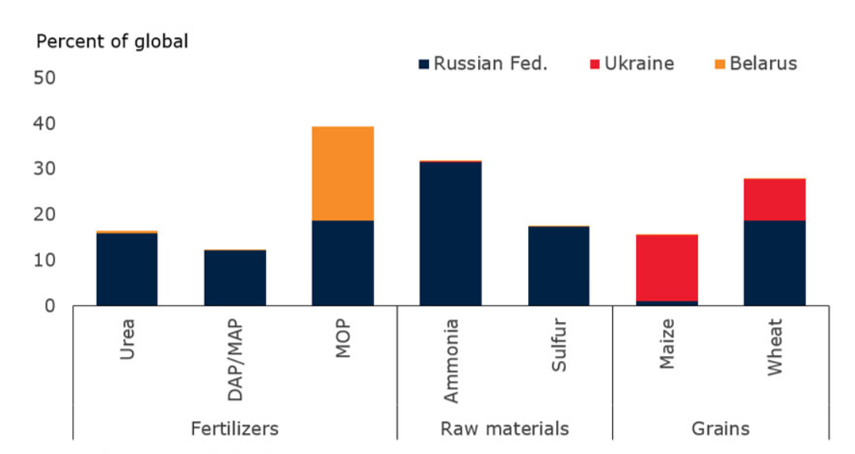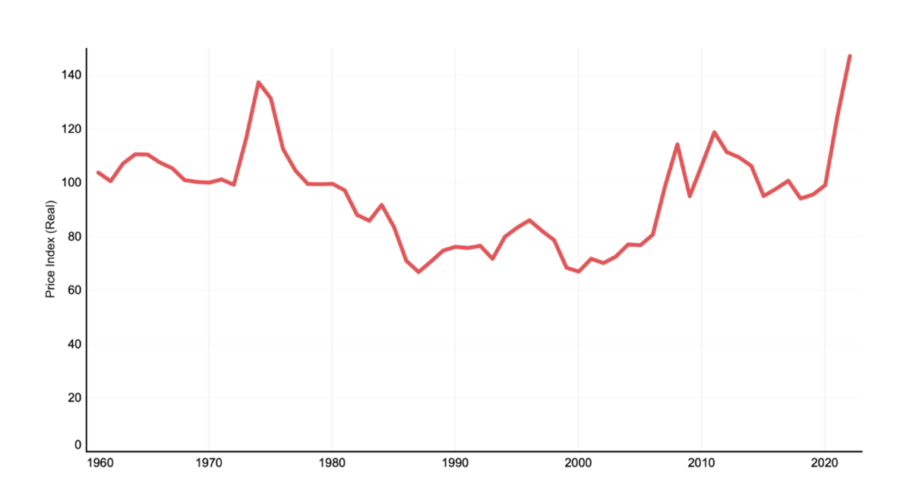Rising coffee prices: Why is coffee so expensive now?

A central topic that not only concerns our partners but also us on a daily basis is the current tense situation in the coffee industry. We would like to take the time to take a closer look at this current topic. We start in our first article with the question that is on everyone’s mind along the supply chain: “Why is coffee so expensive now?”. The interrelationships are globally entangled and very complex. There are some answers to this question and we would like to give you answers from our knowledge and our perspective.
Why is coffee so expensive now?
Climate change
In the last 50 years, the price of green coffee has risen above the USD 2.00/lb mark 8 times. Each time, these increases were provoked by shortages due to climatic events. The most severe two dislocations were the 1975 big freeze in Brazil[1] and the massive outbreak of coffee rust (Hemileia Vastratrix) in Latin America from 2008 to 2013[2]. But even in between, there have been repeated problems with the climate: whether droughts in Brazil in 1986[3] and 2014[4], frosts in Brazil in 1994[5] or El Niño in 1997[6] – the climate regularly makes for expensive coffee years. This is also the case at present.
In the summer of 2021, Brazil experienced the worst frost wave in 50 years. Around 200,000 hectares of coffee plants were destroyed.[7] For the farmers, this was once again a tragedy that threatened their very existence. Nervousness broke out in the coffee industry. Daily price volatility rose to 10% for coffee in general, and up to 17% for Brazilian milds.[8] Compared to the previous year 2020, the price of coffee in October 2021 had increased by 77.9%. Exports of coffee from South America have shrunk by 20.6% in this period.[9] Since then, we have been hovering around USD 2.10/lb – still a price that was last paid when the coffee rust subsided at the beginning of 2012. At least 2-3 years, until the broken coffee plants have grown again, green coffee will probably remain at this price level.

Covid and supply chains
How time flies. Now the pandemic has been with us for two and a half years. Lockdowns, illnesses and fear of infection have made it difficult to harvest coffee cherries in 2020 and 2021.[10] At present, the pandemic seems less dangerous and something like routine has set in. Things like FFP2 or antigen testing have long been part of the new normal. Unfortunately, however, global supply chains have not yet arrived at the Covid 19 daily routine. Logistics centers and ports are groaning under the Corona chaos. The price of a shipped container has increased ninefold to an all-time high between 2020 and 2021.[11] The situation in the ports is particularly dramatic because of the lack of empty containers. They are piling up outside the ports of the USA and are missing everywhere else, especially at Asian hubs.[12] Some ports that for decades were major coffee transshipment points, e.g. Paita-Peru[13], are now unable to ship at all due to container shortages. These medium-term congestion issues are compounded by short-term challenges such as strikes by dockworkers in Germany[14] and Chile[15], globally changing Covid-19 outbreaks, and storms on the seas. Together, these factors are creating an exceptional situation in the global freight industry that has not been seen in the last 25 years. Since 2022, the Ukraine war has also been a decisive factor.

Ukraine war
The war on Europe’s borders painfully reveals some of the Union’s weaknesses. Politicians like to publicly invoke decisive united action, but often fail to take the necessary measures in the complex decision-making apparatus of the EU, neither in dealing with Russia, the cause of the war, nor in monetary policy decisions by the ECB. Verbal aggression is also on the rise. Between Russia, China and the U.S., the EU almost looks small. The euro has depreciated dramatically. With control over key global resources such as wheat and oil, Russia has a power that Europe has underestimated. The common currency has been brought to its knees, hitting a 20-year low of 0.9951 USD/EUR in July 2022. The euro hasn’t even been around that much longer. Since cooperatives and exporters are always paid in USD, the devaluation of the euro alone has increased the price of coffee by around 20% from 2021 to 2022.

But the war in Ukraine is not only making coffee more expensive through foreign exchange trading. The countries directly involved in the conflict, Ukraine, Belarus and Russia, produce large quantities of fertilizer, which are lacking in global agriculture due to the current acts of war and sanctions. The shortage led to a massive increase in the price of fertilizers. The price of urea has more than quadrupled since the start of the 2020 pandemic.[16] As fertilizers become more expensive, farmers around the world are facing higher input costs – in agriculture in general and in coffee in particular.

Figure: Share of Russia, Ukraine and Belarus in global export of fertilizers, raw materials and grain in 2019. | Source: Link
In Vietnam, some coffee farmers are therefore switching to growing durian or avocado, which is why a 10% drop in the harvest is expected for the 2022/2023 season.[17] In Peru, the country of organic coffee, 35% of the farmers are certified and use their own compost fertilizer anyway.[18] They should therefore be able to cope better with this aspect of the crisis. Nevertheless, fertilizers are an important price driver for agricultural products, i.e. food. Hunger was already on the rise before the Ukraine war. Now we are witnessing a dramatic global hunger crisis arising from a whirlwind of conflict, covid19, climate and cost.[19] Traditionally, inhabitants of the tropics, where coffee is cultivated, are particularly at risk.

Figure: Worldwide FAO Food Price Index from 1961 to 2022. | Source: Link
Besides, there is an intra-European effect of the war, which makes prices rise. Many German transport companies work closely with Polish companies. These in turn employ mostly Eastern European drivers, where Ukrainian men take a significant share. In an interview, German Transport Minister Wissing says that an estimated 100,000 Ukrainian truck drivers have been drafted into military service for the war against Russia. That represents 37% of all truck drivers in Poland. The remaining ones have problems with the frequent transports in Germany, because they are officially not allowed to work without further ado as nationals of non-EU countries. Further on, the route via the Silk Road is also used less, because risks are feared there.[20] With the pressure in the national transport industry, prices are also rising here.
Inflation
Inflation takes place when we can buy less and less with our money because prices are rising.[21] After years of stability, inflation in Europe has spiked from 0.3% in December 2020 to 9.6% in June 2022.[22] In the shopping cart, different items are affected to varying degrees. It is particularly severe for all products that have to do with fuel, energy and gas – and these account for the majority. The journey of coffee from the plant to the cup involves many kilometers of transport, which are covered by people for wages. Whether it’s for fertilizer in the growing process, transporting the coffee to the port, or shipping it to the destination country. While fuels are becoming more expensive, the people who provide these services also need more remuneration for their daily expenses, because these are also increasing. Inflation affects not only Europe, but the whole world.[23] Especially in countries with less prosperity, price increases for everyday goods have the potential to trigger humanitarian disasters. Almost all countries of origin of coffee are shown here.

Figure: Inflation rate in the euro area from June 1997 to June 2022. | Source: Link
Climate change again
After the frost event in Brazil, there was this idea that the suffering of some (Brazil) could be the joy of others. The bumper harvests in the industrialized monocultures of Brazil had always had devastating effects for those small farmers of this world who lived in subsistence by hand harvesting in the jungle. Brazil’s high supply had lowered the price of coffee even for those who produced laboriously by hand, often poorly equipped with infrastructure and not connected to roads. So why not change direction now, with the big ones losing and the small ones gaining? Unfortunately, this is not the case. Climate change is the dominant issue in coffee cultivation, and not only in Brazil. Extreme heat, cold and irregular rainfall threaten the delicate coffee plants everywhere. This trend is becoming more dramatic every year. In Peru, climatic conditions in 2021/2022 led to a shortage of coffee. Farmers tell us that the plants produce less than half of the usual coffee, cooperatives hardly find enough coffee to serve their contracts.[24] Coupled with the dramatic increase in the cost of living, the year 2022 is therefore magical for the world’s coffee farmers, despite the high world market price. Again.

Find out more about who is earning from the crisis in our second article.
Sources:
[1] https://www.washingtonpost.com/archive/business/1986/01/15/big-rise-predicted-in-coffee-prices/7c3a6c6c-755a-4afc-86e0-80a93953444a/
[2] https://link.springer.com/article/10.1007/s12571-015-0446-9#:~:text=Coffee%20rust%20is%20a%20leaf,Peru%20and%20Ecuador%20in%202013
[3] https://www.washingtonpost.com/archive/business/1986/01/15/big-rise-predicted-in-coffee-prices/7c3a6c6c-755a-4afc-86e0-80a93953444a/
[4] https://www.theguardian.com/world/2014/feb/25/brazil-drought-threatens-coffee-crops#:~:text=The%20report%20predicted%20coffee%20supplies,futures%20fell%20by%20nearly%2025%25
[5] https://www.latimes.com/archives/la-xpm-1994-07-12-fi-14722-story.html
[6] https://ageconsearch.umn.edu/record/20908?ln=en
[7] https://www.gcrmag.com/brazil-frost/#:~:text=Brazil’s%202022%20harvest%20is%20expected,wilting%20trees%20on%20his%20farm
[8] https://www.ico.org/documents/cy2020-21/cmr-0721-e.pdf
[9] https://www.ico.org/documents/cy2021-22/cmr-1121-e.pdf
[10] https://www.farmersweekly.co.za/agri-news/world/covid-19-delays-2020-coffee-harvest-as-prices-weaken/
[11] https://fbx.freightos.com/
[12] https://ihsmarkit.com/research-analysis/container-shipping-situation-worsens-due-to-congestion-delays.html
[13] https://camcafeperu.com.pe/ES/articulo.php?id=119
[14] https://www.tagesschau.de/wirtschaft/unternehmen/warnstreik-hafenarbeiter-container-stau-hamburger-hafen-101.html
[15] https://klog.co/comunicados/atrasos-en-puertos-de-valparaiso-y-san-antonio-por-paro-de-camioneros
[16] https://blogs.worldbank.org/opendata/fertilizer-prices-expected-remain-higher-longer
[17] https://www.bloomberg.com/news/articles/2022-05-04/avocados-and-durians-help-coffee-farmers-cope-with-surging-costs
[18] https://cafelab.pe/crisis-alimentaria-como-la-escasez-de-fertilizantes-impacta-en-el-cafe-peruano/
[19] https://wnews247.com/2022/06/16/the-spike-in-global-hunger/
[20] https://www.rnd.de/politik/ukraine-fluechtlinge-volker-wissing-gegen-obergrenze-AXMIJF2C4JD55GNLSFO76NOU5A.html
[21] https://www.ecb.europa.eu/ecb/educational/hicp/html/index.de.html
[22] https://de.statista.com/statistik/daten/studie/252059/umfrage/inflationsrate-in-der-eu-nach-monaten/#:~:text=Im%20Juni%202022%20steigt%20die,Inflationsrate%20seit%20Bestehen%20der%20EU
[23] https://www.ft.com/content/088d3368-bb8b-4ff3-9df7-a7680d4d81b2
[24] https://juntadelcafe.org.pe/peru-1200-millones-de-dolares-sumarian-exportaciones-de-cafe-durante-2022/